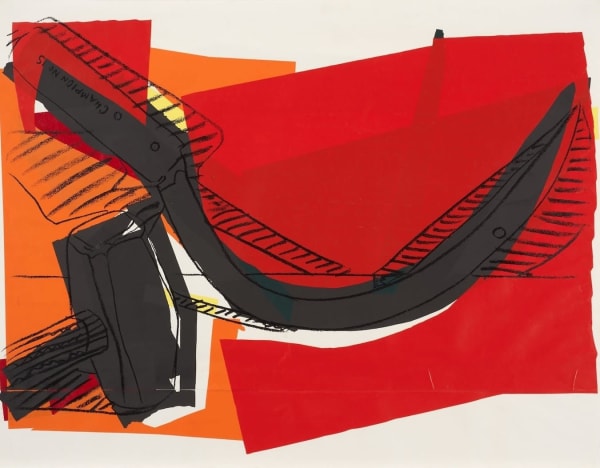
Andy Warhol
Signed and numbered in pencil on lower left.
81.3 x 101.6 cm
Warhol’s Hammer And Sickle (F & S. II 161) is one of four screenprints from Andy Warhol’s 1977 Hammer and Sickle portfolio. Inspired by a trip to Italy in 1976, Warhol was struck by the widespread graffiti of the hammer and sickle—an enduring emblem of the working class and communism. Though not overtly political in intent, Warhol was drawn to the symbol’s repetition, its graphic power, and the cultural weight it carried during the height of Cold War tensions.
Upon his return to New York, Warhol enlisted his assistant Ronnie Cutrone to purchase a real hammer and sickle. He wanted the objects to closely resemble the original Soviet iconography, and used Cutrone’s photographs of the tools as a compositional foundation for the portfolio.
In Warhol’s Hammer And Sickle (F & S. Ii 161), Warhol presents the tools as isolated objects, rendered in stark linework and set against a black background. The head of the hammer rests on the surface with its handle upright, while the sickle leans across it, the two tools intersecting in a carefully balanced arrangement. Bold red hues dominate the forms—an intentional nod to the Soviet flag—while detailed linework mimics the shadows cast by the objects, lending depth and dimensionality to the composition.
Throughout the series, Warhol repositions the hammer and sickle in various arrangements, reframing the infamous symbol with a fresh, artistic lens. The use of red—a color long associated with communism, revolution, and sacrifice—grounds the portfolio in historical reference while enhancing its visual impact. The symbolism is potent, yet Warhol’s treatment is detached, transforming a powerful political icon into an object of visual contemplation.
Although Hammer And Sickle (F & S. Ii 161) does not explicitly champion or critique communist ideology, it reflects Warhol’s broader interest in political imagery. The series follows his earlier Mao portraits (1973) and precedes his Lenin prints (1987), forming part of a larger body of politically themed work that also includes pieces like Vote McGovern and Jimmy Carter. These works collectively showcase Warhol’s fascination with the way political figures and symbols are consumed by the public and filtered through media.
Interestingly, Warhol chose to create a portfolio around the hammer and sickle rather than the American flag—a deliberate move to underscore the cultural and ideological conflicts at the heart of the Cold War. In merging the charged symbol of communism with the commercial style of Pop Art, Warhol delivers a provocative, satirical reflection on power, fear, and the thin boundary between propaganda and pop culture.
Hammer And Sickle (F & S. Ii 161) is a compelling example of Warhol’s ability to deconstruct contemporary symbols and recontextualize them within an aesthetic framework. Through this series, Warhol illuminates how easily political imagery can shift from ideological tool to visual commodity—an insight that remains as relevant today as it was during his time.
For more information on Warhol’s Hammer And Sickle (F & S. II 161) or to buy Hammer And Sickle (F & S. II 161), contact our galleries using the form below.
Join our mailing list
* denotes required fields
We will process the personal data you have supplied in accordance with our privacy policy (available on request). You can unsubscribe or change your preferences at any time by clicking the link in our emails.
This website uses cookies
This site uses cookies to help make it more useful to you. Find out more about cookies.



